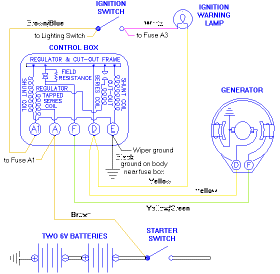The MGA With An Attitude
IGNITION WARNING LAMP - ET-120A
What It Does And Doesn't Do
On 5/28/2018, Christopher Chadwick wrote:
"My ignition light only comes on intermittently. It often doesn't come on when the engine revs are very low, and often when the ignition is on but the engine is not running. At other times it works OK. Any ideas?
 Yes. Please click on the diagram for a larger image in a separate window. You will need to refer to this diagram for the following notes. Oddly enough, the Ignition Warning Lamp has very little to do with ignition, but refers mostly to operation of the generator and control box.
Yes. Please click on the diagram for a larger image in a separate window. You will need to refer to this diagram for the following notes. Oddly enough, the Ignition Warning Lamp has very little to do with ignition, but refers mostly to operation of the generator and control box.
The ignition lamp can be useful, sometimes. If it lights up when the engine is running it implies (not proves) that the generator is low in current output and not charging the battery. If it does NOT light up when ignition is switched on with engine not running, it implies (not proves) that something in the circuit is disconnected. In any case it does not tell you what the fault is, but it does alert you to some kind of fault so you can begin the diagnostic work (hopefully before your battery goes dead while you are driving).
The lamp is connected between ignition switch output and the "D" terminal on the control box. Control box "D" should be directly connected to generator "D". This should be connected through the control box to the battery when the generator is working. The lamp is an "indicator" of a specific condition, but otherwise has nothing to do with actual operation of the generator or control box or battery charging (or discharging).
What the lamp is doing is monitoring voltage difference between ignition switch (battery voltage) and Dynamo output voltage. When first switched on the lamp sees 12V from ignition switch and no output from the generator. The generator will be "sinking" current to ground through the armature windings. The lamp sees the "D" circuit as a ground connection and lights up brightly.
When engine is running, and the generator is charging properly, the "D" terminal is up around 12-15 volts, a fairly close match to battery voltage (ignition switch output), so very little current flows through the lamp, and the lamp will be dark. When engine is idling slowly the Dynamo output voltage can be significantly lower, say 10-volts perhaps. The lamp then has 12V input from ignition switch and 10V on the other side, which may be enough voltage difference to make the lamp glow dimly (which may be perfectly normal).
If the control box suffers failure of the regulator relay, and the relay contacts remain closed at all times, then high speed of the engine would make the generator overcharge at abnormally high voltage. This condition can boil water out of the battery, and can cause internal melt down of the generator. As this is happening the charging output voltage may be as high as 18-20 volts. The voltage is limited by maximum output capacity of the generator and the battery sinking current. The lamp then sees "D" terminal voltage significantly higher than the ignition switch output, so current flows the opposite direction, and the lamp may glow dimly as the generator is overcharging the battery.
You might realize that function of this lamp would be somewhat different if you installed an LED here, because the LED has much higher resistance and is a one-way electrical valve. An LED will usually light up brightly at much lower voltage and with minuscule current, and will not light up at all with reverse bias (higher voltage on the downstream side). It is definitely not recommended to use an LED for the ignition lamp.
When the ignition lamp is not working properly, start by checking the bulb itself, then the bulb socket contacts, and then the wire connections on either side of the lamp. If in doubt about the wiring or wire connections, use a jumper wire to make the connection between ignition switch and lamp socket, and/or between lamp socket and "D" on the control box or generator. Or connect a test light between ignition switch and generator "D" terminal for comparison. If the test light does exactly the same thing as the dash lamp, then the lamp and socket and wiring is most likely okay, and the fault will be in the generator or control box.
Test the generator first, by the book. Disconnect wires from the generator. Connect "D" to "F" on the generator, and measure voltage between "D" and engine ground. Beginning at idle speed, increase engine speed slowly, and look for the charging voltage to rise quickly. It should make 20 volts by 2500 rpm (or earlier). Do not run any faster to exceed 20 volts. If it does make 20 volts the generator is good. Then check all wiring connections before concluding the control box may have failed.
|